Home /
Second Degree AV block - Mobitz II - ECG
2nd degree AV block, Mobitz II
Atrioventricular (AV) Node

- In sinus rhythm, impulses are generated regularly (approx. 60/min.) in the SA node
- Each impulse travels through the atria (P wave) to the AV node
- In the AV node, the impulse slows down by approximately 0.1s
- The atria have time to pump blood into the ventricles during this delay
- Then the impulse continues to the ventricles (QRS complex)
PQ Interval

- Impulse originates in SA node
- When it passes to the atrial myocardium, P wave starts to form
- Simultaneously, it travels through the conduction system towards the AV node
- Impulse in the conduction system does not create a curve
- Impulse enters the AV node
- Impulse from the SA node propagates
- At the time of atrial activation (peak of the P wave)
- Arrives through the conduction system to the AV node
- Delayed (decremental) conduction in the AV node
- Impulse "lingers" in the AV node for approx. 0.1s (no curve is formed)
- Then it proceeds to His bundle (no curve is formed)
- Activation of the ventricular septum
- From the His bundle, impulse through Purkinje fibers
- Starts to activate the ventricular septum myocardium
- Initiates the Q wave
AV Block of the Second Degree - Mobitz II
- It is an intermittent block of impulses, always infranodal (below the AV node)
- Impulses can be blocked infranodally in 3 locations:
- His bundle (in the His bundle)
- At the beginning of the Tawara branches
- In the right Tawara branch and in the fascicles
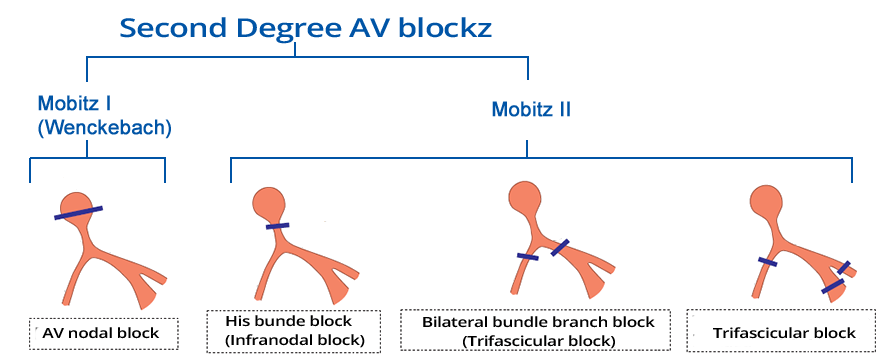
- In the case of AV node dysfunction, Wenckebach phenomenon occurs: AV Block of the Second Degree - Mobitz I - Wenckebach
- Conduction of impulses through the AV node gradually prolongs
- Until the impulse is blocked. Then the cycle repeats
- In the case of infranodal dysfunction (below the AV node), AV Block of the Second Degree - Mobitz II occurs
- The principle of "all or nothing" applies, the impulse is either conducted or blocked
- Blockage of all impulses is AV Block of the Third Degree (absolute isolation of the atria from the ventricles)
- AV Block of the Second Degree - Mobitz II
- Is more dangerous than Mobitz I
- Patients with Mobitz II are indicated for the implantation of a pacemaker
- Mobitz I does not require a pacemaker
ECG and AV Block of the Second Degree - Mobitz II
- PP interval is consistently the same
- PQ interval is consistently the same
- Intermittently, P waves are blocked
- No QRS complex follows a blocked P wave
- The RR pause is exactly twice the RR interval


AV Block of the Second Degree - Mobitz II
- PP interval is consistently the same
- PQ interval is consistently the same
- No QRS complex follows the 1st and 5th P waves
- Because the impulse was blocked in the infranodal area (in the His bundle)
- Conduction to the ventricles is (4:3)
- Out of 4 P waves, 3 P waves are conducted to the ventricles (resulting in 3 QRS complexes), then the cycle repeats
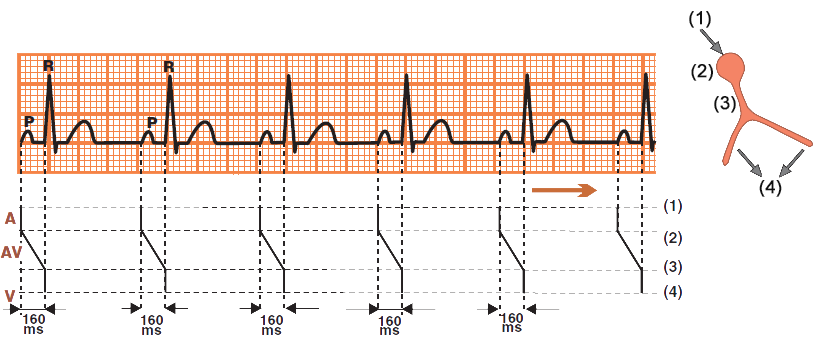
Sinus Rhythm

AV Block II Degree - Mobitz II
- PP interval is constant (720ms)
- PQ interval is constant (190ms)
- Every 3rd P wave is blocked in the His bundle
- No QRS complex follows it
- Conduction to the ventricles is (3:2)
- Out of 3 P waves, 2 P waves are conducted to the ventricles (resulting in 2 QRS complexes), then the cycle repeats
AV Block II Degree (Mobitz I, Mobitz II)
- Woldemar Mobitz
- He was a Russian physician who worked as a cardiologist in Germany
- In 1924, he described AV Block II Degree on ECG and divided it into 2 types (Mobitz I, II)
- Mobitz I (Wenckebach)
- It is often referred to as Wenckebach
- Because the Wenckebach phenomenon occurs in the AV node
- Mobitz II (Hay)
- John Hay was an English physician who described this AV block II degree in 1906 based on pulse (without ECG)
- Later, Mobitz described it in more detail; it is more commonly referred to as Mobitz II, rarely as Hay
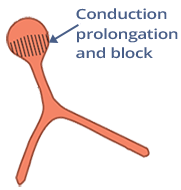

AV Block II Degree (Mobitz I)
- The disorder is in the AV node
- Mobitz I features the Wenckebach phenomenon:
- PQ interval gradually prolongs
- Until the 5th P wave is blocked, then the cycle repeats
- Conduction to the ventricles is (5:4)


AV Block II Degree (Mobitz II)
- The disorder is infranodal (below the AV node)
- PQ interval remains constant (Wenckebach phenomenon is not present)
- AV Block II Degree, Mobitz II
- Any P waves are intermittently blocked (without prolongation of the PQ interval)
- The infranodal area of the AV junction intermittently blocks impulses
- Conduction to the ventricles is (4:3)
Narrow QRS Complex (<0.12s)

Narrow QRS Complex (<0.12s)
- This is a His bundle AV block II degree - Mobitz II
- 25% of Mobitz II AV blocks have a narrow QRS complex (<0.12s)
- The ventricles (narrow QRS complex) are activated through the conduction system similar to sinus rhythm
- There is intermittent blockage of impulses in the His bundle
- This appears on the ECG as blocked P waves (no QRS complex follows them)
Wide QRS Complex (>0.12s)

Wide QRS Complex (>0.12s)
- This is a infra-Hisian AV block II degree - Mobitz II
- 75% of Mobitz II AV blocks have a wide QRS complex (>0.12s)
- Mobitz II can block impulses infra-Hisianly: at the level of Tawara's branches or fascicles
- The likelihood of intermittent blockage at once at
- 2 locations (2 Tawara's branches)
- 3 locations (2 fascicles and the right Tawara's branch)
- is minimal
- Patients have a wide QRS complex because they have a pre-existing:
- In sinus rhythm, impulses reach the ventricles only through one intact Tawara's branch (Fascicle)
- On the ECG, there is a wide QRS complex
- Intermittently there is blockage of impulses in the unblocked Tawara's branch (Fascicle)
- This appears on the ECG as blocked P waves (no QRS complex follows them)
Ventricular Conduction
- Sinus rhythm has a ventricular conduction of 1:1 (P:QRS)
- After every P wave comes a QRS complex
- In AV block II degree, some P waves are blocked (in the AV node)
- Therefore, ventricular conduction is not 1:1
- AV block II degree - Mobitz II most commonly has ventricular conduction of: 3:2, 4:3, 5:4, 3:1, 4:1
- Variable ventricular conduction means that the conduction to the ventricles changes on the ECG, e.g.:
- AV block II degree - Mobitz II with variable ventricular conduction (3:2) and (4:3)
- AV block II degree with ventricular conduction (2:1)
- Could it be Mobitz I or Mobitz II?


AV Block II Degree - Mobitz II (3:1)
- The PP interval remains unchanged
- After every 3rd P wave there is a narrow QRS complex
- The ventricular conduction is 3:1
- Narrow QRS complexes (<0.12s)
- This is a His bundle AV block II degree - Mobitz II
- There is also AV block I degree
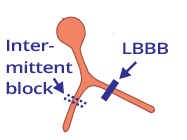

AV Block II Degree with Conduction (2:1)
- The PP interval remains unchanged
- After every 2nd P wave, there is a wide QRS complex
- The ventricular conduction is 2:1
- AV Block II Degree with Conduction (2:1) is a diagnostic challenge
- It could be either Mobitz I or Mobitz II
- Wide QRS complexes (>0.12s)
- This is more indicative of AV Block II Degree - Mobitz II
- AV Block II Degree - Mobitz I is unlikely
- Because it creates narrow QRS complexes (>0.12s)


AV Block II Degree - Mobitz II (3:2 and 2:1)
- The PP interval remains unchanged
- Every 3rd or every 2nd P wave is blocked (some P waves are hidden within the T wave)
- There is a variable conduction to the ventricles 3:2 and 2:1
- Narrow QRS complexes (<0.12s)
- This indicates a hisian AV block II Degree - Mobitz II


AV Block II Degree - Mobitz II (4:3)
- The PP interval remains unchanged
- Every 4th P wave is blocked
- Conduction to the ventricles is 4:3
- Narrow QRS complexes (<0.12s)
- This indicates a hisian AV Block II Degree - Mobitz II


AV Block II Degree with Conduction (3:2)
- The PP interval remains unchanged
- Every 3rd P wave is blocked
- Conduction to the ventricles is 3:2
- Wide QRS complexes (>0.12s)
- Indicates an infrahisian AV Block II Degree - Mobitz II
- Patient has a preexisting left bundle branch block (deep S in V1)
- And intermittently blocks the right bundle branch

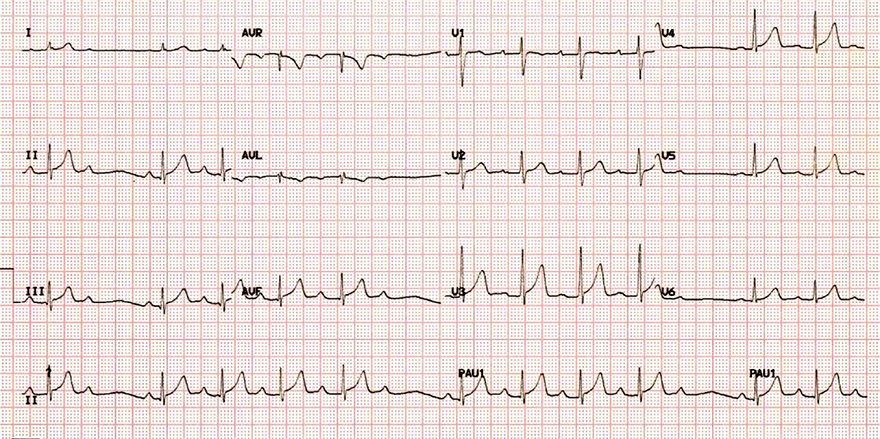
AV Block II Degree - Mobitz I (Wenckebach)
- PP interval is constant
- PQ interval gradually lengthens
- Until a P wave is blocked
- The cycle then repeats
- Conduction to the ventricles is 5:4
- Every 5th P wave is blocked
- The issue is in the AV node
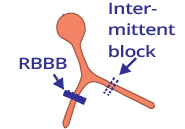
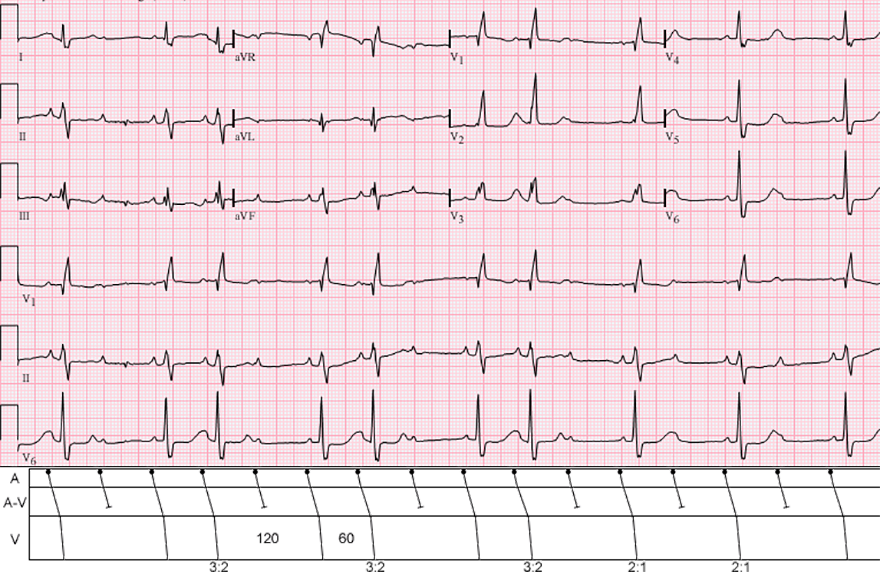
AV Block II Degree - Mobitz II
- Laddergram illustrates the spread of impulses through the conduction system
- A - Atria, AV - AV junction, V - Ventricles
- PP interval is constant
- PQ interval is constant
- Every 3rd or every 2nd P wave is blocked
- There is a variable conduction to the ventricles of 3:2 and 2:1
- QRS complexes are wide (>0.12s) and have the appearance of right bundle branch block (RBBB)
- Thus, the impulse passes to the ventricles only through the left bundle branch
- In the left bundle branch, impulses are intermittently blocked
- As seen by the fact that no QRS complex follows the P wave
- AV Block II Degree - Mobitz II occurs because
- impulses are intermittently blocked in the left bundle branch


AV Block II Degree - Mobitz II
- PP interval is constant (800ms)
- PQ interval is constant (190ms)
- The PQ interval after a blocked P wave is the same as the PQ before the blocked P wave
- This is AV Block II Degree - Mobitz II
- Because PQ interval remains constant, even after a blocked P wave


AV Block II Degree - Mobitz I (Wenckebach)
- PP interval is constant (800ms)
- PQ interval is constant (190ms), except for the PQ interval after a blocked P wave (160ms)
- The PQ interval after a blocked P wave is shorter than the PQ before the blocked P wave
- The PQ interval after the blocked P wave (160ms) is shorter by 30ms
- compared to the PQ before the blocked P wave
- This is AV Block II Degree - Mobitz I (Wenckebach)


AV Block II Degree - Mobitz II
- PP interval is constant (800ms)
- PQ interval is constant (190ms)
- PQ interval after a blocked P wave is the same
- as the PQ interval before the blocked P wave
- This is AV Block II Degree - Mobitz II (High Degree)
- because two consecutive P waves are blocked


AV Block II Degree - Mobitz II
- The ECG shows bifascicular block
- This is AV Block II Degree - Mobitz II
- Intermittent blockage of impulses (in the left posterior fascicle)
- PP interval is constant
- PQ interval is constant
- Conduction to the ventricles is (3:2) and 1x (2:1)


AV Block II Degree - Unclassified
- The PP interval is constant
- The PQ interval is constant
- The PQ interval after a blocked P wave is not visible on the ECG
- If the PQ interval after the blocked P wave were
- Shortened - it would indicate Mobitz I
- Constant - it would indicate Mobitz II
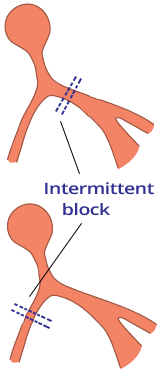
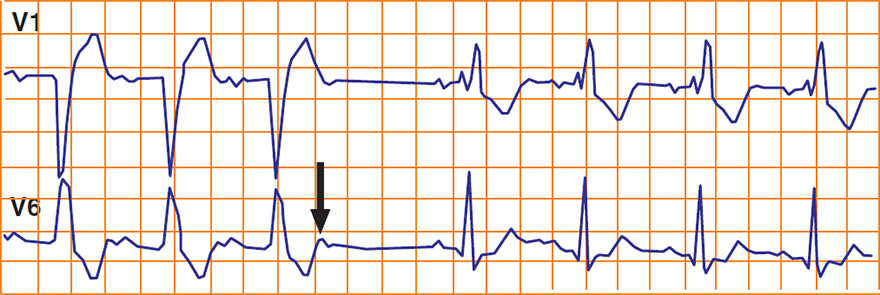
Alternating Tawar Bundle Branch Block
- At the beginning of the ECG there is a left Tawar bundle branch block (LBBB)
- After a atrial extrasystole
- This indicates a severe damage to the conduction system
- Both Tawar bundle branches are damaged
- PQ interval with LBBB is longer than the PQ interval with RBBB
- This suggests that the right Tawar bundle branch is more damaged
- Because it takes longer to activate the ventricles
- Such a patient may develop
- A patient with such an ECG is indicated for the implantation of a pacemaker
Sources
- ECG from Basics to Essentials Step by Step
- litfl.com
- ecgwaves.com
- metealpaslan.com
- medmastery.com
- uptodate.com
- ecgpedia.org
- wikipedia.org
- Strong Medicine
- Understanding Pacemakers













































































